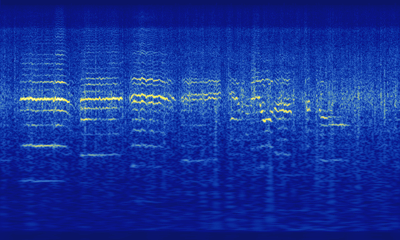Graphical sound denoising challenge
Removing noise from recorded sound has always been a difficult problem, requiring the use of specific electronic circuits or dedicated computer algorithms. With the recent advent of image-based processing of sound it is now possible to tackle this problem from a different angle with such simple and ubiquitous tools as image editing programs. This is the object of this challenge, denoising sound using graphical techniques.
The sound chosen for this challenge is a 1894 recording of Daisy Bell by Edward M. Favor. Dating from the early days of sound recording, it's suffers from heavy noise and artifacts. The goal of this challenge is to remove these undesirable features in a graphical way while preserving the vocal and musical elements in order to enhance the sound quality of this recording.
An extract from the recording

This is an example of the original extract being denoised graphically. It was done in Photoshop in a few minutes using some very simple operations.
Prizes :
The prizes are two full licenses of Photosounder each worth €99, one for each of the following category of entries :
Deadline:
All entries must be sent by e-mail to challenge@photosounder.com before July 16th at noon GMT. The entries will then be reviewed by a panel of listeners and the results will be announced a few days later.
What you'll need :
Rules :
Tips :
The sound chosen for this challenge is a 1894 recording of Daisy Bell by Edward M. Favor. Dating from the early days of sound recording, it's suffers from heavy noise and artifacts. The goal of this challenge is to remove these undesirable features in a graphical way while preserving the vocal and musical elements in order to enhance the sound quality of this recording.
An extract from the recording

This is an example of the original extract being denoised graphically. It was done in Photoshop in a few minutes using some very simple operations.
Prizes :
The prizes are two full licenses of Photosounder each worth €99, one for each of the following category of entries :
- The image-editor category : For entries done entirely with an image-editor and reproducible by any user of such a program.
- The algorithmic category : For any other entry, but more particularly for entries involving the use of custom-written image-processing code or any process beyond the usage of publicly available user-level tools.
Deadline:
All entries must be sent by e-mail to challenge@photosounder.com before July 16th at noon GMT. The entries will then be reviewed by a panel of listeners and the results will be announced a few days later.
What you'll need :
- The demo version of Photosounder for Windows/Mac OS X. The demo version doesn't allow you to save the sound but it allows you to save the image which is all you'll need here.
- The original recording which you can download here. A short extract and its image have been included for the sake of convenience during experimentation.
- An image editor such as Adobe Photoshop or GIMP, unless of course you wish to write your own algorithm.
Rules :
- A valid entry must consist in the resulting image of dimensions 15,379 x 571, preferably in PNG format, as well as an account of how the image was obtained detailed in a way that would allow the reproduction of the process, and sent by e-mail to challenge@photosounder.com before the deadline.
- Your denoising method must be practical to use on long sounds and be reproducible in a few minutes of work on a sound of several minutes. Therefore this excludes the recourse to such techniques as paintbrushing parts of the image out.
Tips :
- To hear your results the way they should be heard make sure to use Photosounder's lossless mode. To do so first load the original sound in Photosounder then load the modified image corresponding to that sound and activate the lossless mode.
- If in your sound you hear artifacts similar to bubbling it may be that in your modified image so pixels are much brighter than they originally were. To make sure it doesn't happen you can overlay your modified image with a copy of the original image and set the blending mode of the original image to 'Darken' so that it prevents any single pixel from being brighter than it originally was.
Labels: challenge, denoising, experiments, filtering, lossless


0 Comments:
Post a Comment
Links to this post:
Create a Link
<< Home